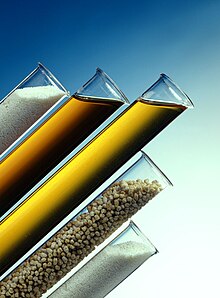
Back ليسيثين Arabic Лецитин Bulgarian লেসিথিন Bengali/Bangla Lecitin BS Lecitina Catalan Lecitin Czech Lecitin Danish Lecithine German Λεκιθίνη Greek Lecitino Esperanto


Lecithin (/ˈlɛsɪθɪn/ LESS-ith-in; from the Ancient Greek λέκιθος lékithos "yolk") is a generic term to designate any group of yellow-brownish fatty substances occurring in animal and plant tissues which are amphiphilic – they attract both water and fatty substances (and so are both hydrophilic and lipophilic), and are used for smoothing food textures, emulsifying, homogenizing liquid mixtures, and repelling sticking materials.[1][2]
Lecithins are mixtures of glycerophospholipids including phosphatidylcholine, phosphatidylethanolamine, phosphatidylinositol, phosphatidylserine, and phosphatidic acid.[3]
Lecithin was first isolated in 1845 by the French chemist and pharmacist Théodore Gobley.[4] In 1850, he named the phosphatidylcholine lécithine.[5] Gobley originally isolated lecithin from egg yolk and established the complete chemical formula of phosphatidylcholine in 1874;[6] in between, he demonstrated the presence of lecithin in a variety of biological materials, including venous blood, human lungs, bile, roe, and brains of humans, sheep and chicken.
Lecithin can easily be extracted chemically using solvents such as hexane, ethanol, acetone, petroleum ether or benzene; or extraction can be done mechanically. Common sources include egg yolk,[7] marine foods, soybeans,[7] milk, rapeseed, cottonseed, and sunflower oil. It has low solubility in water, but is an excellent emulsifier. In aqueous solution, its phospholipids can form either liposomes, bilayer sheets, micelles, or lamellar structures, depending on hydration and temperature. This results in a type of surfactant that usually is classified as amphipathic. Lecithin is sold as a food additive and dietary supplement. In cooking, it is sometimes used as an emulsifier and to prevent sticking, for example in non-stick cooking spray.
- ^ "Lecithin". Merriam Webster Dictionary Online. Archived from the original on 2018-06-12. Retrieved 2015-11-18.
- ^ Szuha BF (1989). "Chapter 7". Lecithins: Sources, Manufacture & Uses. The American Oil Chemist's Society. p. 109. ISBN 0-935315-27-6.
- ^ Smith J, Hong-Shum L, eds. (2011). Food Additives Data Book (2nd ed.). Chichester, West Sussex: Wiley-Blackwell. p. 334. ISBN 978-1-4443-9773-4.
Complex mixture of phosphatidylcholine, phosphatidylethanolamine, phosphatidylinositol, phosphatidic acid, glycolipids, etc.
- ^ Gobley T (1846). "Recherches chimiques sur le jaune d'œuf" [Chemical researches on egg yolk]. Journal de Pharmacie et de Chemie. 3rd series (in French). 9: 81–91.
- ^ Gobley T (1850). "Recherches chemiques sur les œufs de carpe" [Chemical researches on carp eggs]. Journal de Pharmacie et de Chemie. 3rd series (in French). 17: 401–430.
Je propose de donner au premier le nom de Lécithine (de λεκιθος, jaune d'œuf), parce qu'on le rencontre en grande quantité dans le jaune d'œuf … (I propose to give to the former the name of lecithin (from λεκιθος, egg yolk), because it is encountered in great quantity in egg yolk … )
- ^ Gobley T (1874). "Sur la lécithine et la cérébrine" [On lecithin and cerebrin]. Journal de Pharmacie et de Chimie. 4th series (in French). 19: 346–353.
- ^ a b "Lecithin: Uses, Side Effects, Interactions, Dosage, and Warning". WebMD. 2019-01-30. Archived from the original on 2019-06-18. Retrieved 2019-06-18.
© MMXXIII Rich X Search. We shall prevail. All rights reserved. Rich X Search